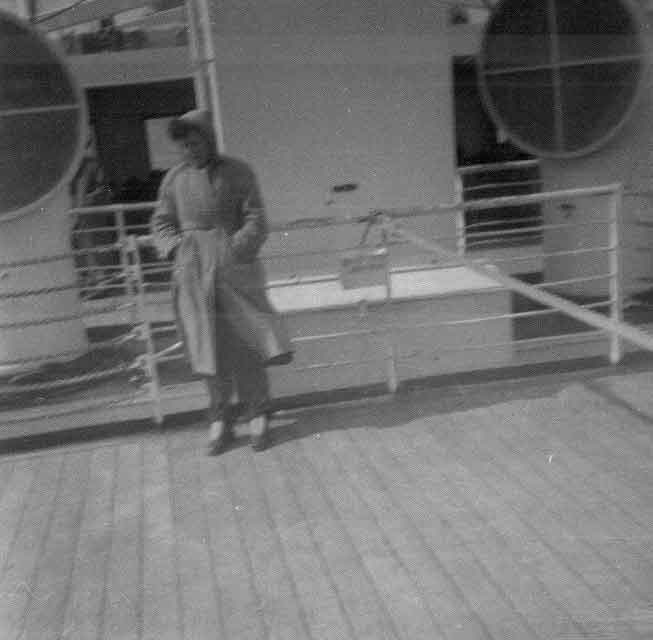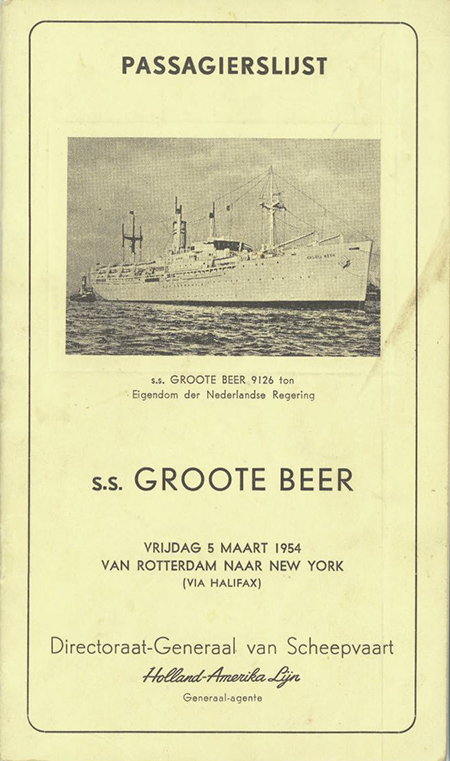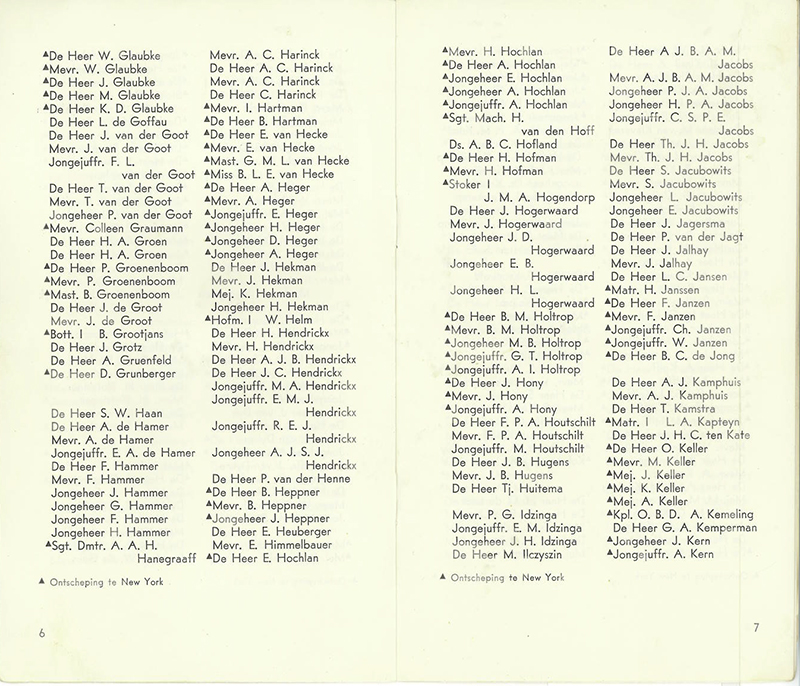Sobey Wall of Honour
Column
124
Row
6
Heading for a Good Life in Canada
By Carla White
When Theodorus Jacobs (a.k.a. Theo) saw the vessel that would take him and his wife Maria to Canada on March 5, 1954, he thought to himself, “welcome home”. This wasn’t the first time Theo would set voyage from the Netherlands upon the Groote Beer (Great Bear), but it was the first time that the promise and hope of a new life awaited him on the other end.
Theo first boarded the Groote Beer with many other Dutch soldiers in February 1949 and set sail to Indonesia, where they where stationed until August 1950.
Though he never attended high school due to the outbreak of the Second World War, Theo took a bookkeeping course during his free time in Indonesia and upon returning from Indonesia went to Agricultural College for three days a week (a 20 km bike ride one way) – both of which would prove useful in the years to come.
After the war, the Dutch army tried to convince soldiers to go to Australia instead of returning home. But soldiers knew that women in Oz at the time didn’t like foreigners, so they went back to the Netherlands to find wives. He would have considered going to New Zealand but that was not offered.
Within the year of Theo returning, the Netherlands pulled out of Indonesia and, the situation was dire – commoners were being killed and the Dutch were being blamed. When Dutch soldiers returned home, they were not appreciated. Between this and suffering from Post Traumatic Stress Syndrome, up to 30 per cent of those who came back from Indonesia, left the Netherlands again.
Theo stayed for the time being. Upon returning, the Dutch army sent him to college in the winter of 1951-52, where he met the farmer’s son where he would work. Over the next 18 months, he learned to drive tractors and other mechanized farm techniques such as milking machines.
But the government and the church in the Netherlands didn’t help the situation, as they both tried to push residents into leaving the country. Priests and bishops would travel to local agricultural schools to talk to students about emigrating. This is where Theo first considered the idea.
“I saw the world and worked on the farm for a while; but for me, emigrating was a way out,” explains Theo, whose mother told him that if he wanted to make a living, he needed to get out of the Netherlands. “You could see that the world was bigger than just where you were from,” he adds.
When a bishop came to speak at the college where Theo was studying, Theo asked the bishop which country he would choose to emigrate to, and the bishop said Canada. From then on, Theo decided that was where he would go.
He says the decision to leave wasn’t that difficult. After the war, nothing was going on in the Netherlands – factories were shut down, the Netherlands wanted people to leave, and his friend who went to Canada the year before wrote letters of how wonderful the experience was, which added to Theo’s decision.
Theo didn’t leave right away – preparations were needed, courses had to be taken, and he met a woman who would first have to become his wife before they could emigrate together.
Theo met Maria at a New Year’s dance he attended with a college friend who happened Maria’s cousin, but he didn’t mention his desire to go to Canada until they had been dating for a year. It didn’t take much to convince her as emigrating would be a way for her to leave her domineering family.
So, in 1953, they started to plan by taking emigration courses, learning English, and physical health tests. One such course included a three-day weekend course hosted by a Catholic group where Theo and Maria were given all of the information they needed to emigrate – particularly information that didn’t seem to be common knowledge among the general public and other emigrants. Theo especially remembers the golden rule: “In Canada, they don’t like to argue much, so don’t talk about politics and religion in public and you’ll be ok.”
They were taught about the Canadian culture and that, if you can count, you can do business. This is where Theo’s bookkeeping knowledge and experience came in handy.
Theo asked Maria’s father if he could take her to Canada, and he said “yes, but you have to marry her.” So, one week (10 days actually) before they left on the Groote Beer, Theo and Maria celebrated during a two-day wedding.
A week later, some of their family members saw them off at the train station. Theo’s Mother was convinced that she would never see him again, but he returned to the Netherlands many times over the years to visit. And every time, his mother would say, “This’ll be the last time.” Eventually, she was right.
Emigrants had to pay their own way on the ship and it cost about 1,800 Guilders for room and board and shipping personal belongings. They were allowed to bring a limited amount of cash out of the Netherlands, and the limit of household items they could bring to Canada was up to 2500 Guilders.
They arrived with $20 in cash and $370 in travelers cheques (about 100 guilders) So Theo and Maria packed up a kitchen table and chairs, a bedroom suite, clothes, and bedding, which were picked up at home and arrived in Canada three weeks after they did.
Theo didn’t know until he arrived at the harbour to get on the boat to Canada that it was the same one that took him to Indonesia and back. While the weather going to Canada was more miserable than going to Indonesia, he says the sleeping accommodations this time around were much better. Hammocks were replaced with beds with men and women in their separate dormitories.
The weather was stormy throughout their voyage, causing travel to take nine-and-a-half days instead of eight, and many people were seasick, including Maria. Theo says the food was fine and passengers had to make sure to drink lots, even if they were seasick. The sleeping quarters were large rooms with about 100 beds in each, stacked five high. “To me, it was a big surprise that it was better,” says Theo, when comparing his two voyages on the Groote Beer. Maria wondered what she had gotten herself into.
There wasn’t much to do on the ship, other than study more and talk with other emigrants. Theo remembers the first time he saw land – Greenland in the distance with lots of rocks – then more rocks as they neared Newfoundland. As they floated past, he wondered, “Is there any soil in this country,” because all he could see were rocks.
They arrived at Pier 21 in Halifax on March 14, 1954, which happened to be Theo’s birthday; but, he wouldn’t get the gift of Canadian soil until the next day as it was too late to get off the boat that night. So, they spent another night on the Groote Beer on the rocky Halifax shore at Pier 21.
Theo and Maria could speak more English than most other emigrants, so they were quick to go through immigration in the building that is now the museum. They were advised to purchase some groceries before catching the train to their final destination as it would be three days to go from Halifax to London, Ontario.
The train made a brief pit stop in Toronto at the Salvation Army where they were given coffee and donuts. This was the first time Theo had donuts and it was his first impression of Canada and something he’s never forgotten.
It snowed all the way from Halifax to London and Theo was dismayed to see that they didn’t leave the snow behind in the Netherlands, despite having arrived near spring.
Theo’s immigration forms specified that his trade was farming, so the Department of Immigration arranged for him to work on a farm, which is why he emigrated in the spring – the time when farmers need the most help.
In London, Theo and Maria were picked up by a local immigration official and taken to Stratford, since that was where he lived. They stayed their first night in a hotel before the farmer he was to work for came to pick them up. Every time he sees that hotel, he’s reminded of the place where he had his first good sleep in Canada.
The dairy farm in Stratford where Theo worked when he first arrived in Canada also had another Dutchman working throughout the winter, which helped Theo and Maria make the transition into Canadian life. Theo also bought a radio and they learned better English by listening to Lloyd Robertson announce the news on the local radio station.
Theo was left to milk the cows on his own after just one day of learning, and Maria was supposed to help in the house. It was also maple syrup season, which was a new experience for Theo as the Netherands didn’t educate him on this Canadian tradition.
When spring arrived and crops were planted, farming life wasn’t much different from that in the Netherlands. Maria worked part-time for another Dutch couple before becoming pregnant with their first of five children. At the time, they were living in a former woodshed that had been converted into living quarters with no plumbing. Theo says it was so cold in the bedroom, even the chamber pot froze.
That fall, the dairy farmer took Theo to his first (of many) International Plowing Match in Breslau. The next day, Hurricane Hazel ripped through and they couldn’t get into the field for two weeks until the land dried. “This was hard on a farmer’s nerves,” he recalls.
Though the farmer didn’t always hold up his end of the bargain with decent pay, neighbours were very good to Theo and Maria – one even took Theo to the hospital when their first son was born and Theo didn’t have his own car.
After two years at the dairy farm in Stratford, Theo decided it was time to leave as the farmer wasn’t paying him enough. He went on to work at another dairy farm,, but lived on a mink ranch where the living quarters above the ranch weren’t ideal, but he was paid twice as much money – $120 per month. At his third job, in St. Mary’s, Theo made $180 a month and he and Maria were able to live in one half of a house with two older spinster sisters in the other half who would babysit for their growing family of now four children.
With more kids, a bigger house was needed, and with more money, it was possible. In 1960, Theo bought 100 acres of land in Ayton, with a house and a barn, for $5,500 at an auction. It was in Ayton that their fifth child was born.
Their second farm came in 1965, and a third in 1976. “I’m good at bookkeeping, I think that’s the only reason I had the money and others didn’t,” Theo said of his ability to purchase his own farms.
Maria approved of the first two farms, but was mad when Theo bought the third. He claims it was his retirement plan for them. Unfortunately, that plan never completely came to fruition as Maria passed away in March, 1992.
Theo re-married in 1995 and says it was similar to emigrating because everything was new again – especially having his in-laws so near. “I never had that,” he says. “Before, they would come from the Netherlands to visit, and then leave again.”
Though he was happy living in Canada, Theo always wondered if he made the right choice. So in 1999, he took a trip to New Zealand and Australia just to make sure. He says that while he could have lived in New Zealand, as it was similar to the Netherlands in terms of land and sheep, Australia was too dry and hot.
But with his land and wealth of family and extended family here in Canada, Theo says he is happy with his choice. When his brother passed away in 2012, the top of his obituary read, “I had a good life.” “I think I could say the same,” says Theo, with a smile.
(Note: Unfortunately, there are no pictures of when they landed in Halifax. Everything was packed including the camera, expecting to leave the ship on March 14, 1954 (Theo’s 26th birthday). However, it was late in the day when the ship docked, and immigration was closed. They had to stay the extra night on board and were allowed to disembark on March 15.)
















